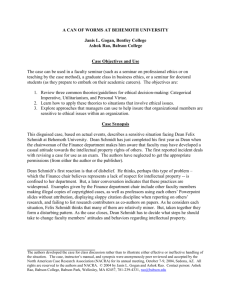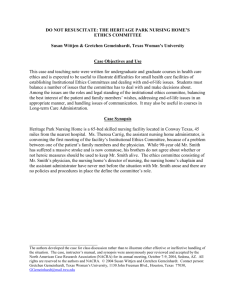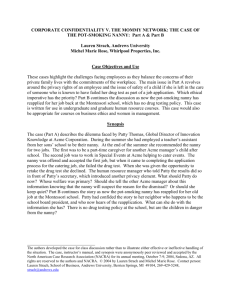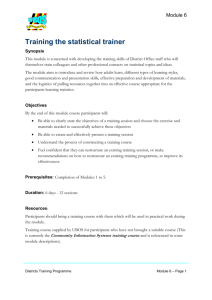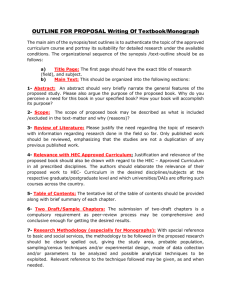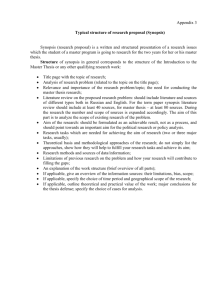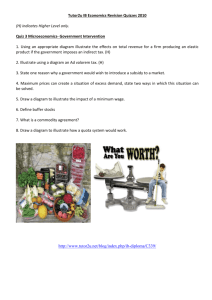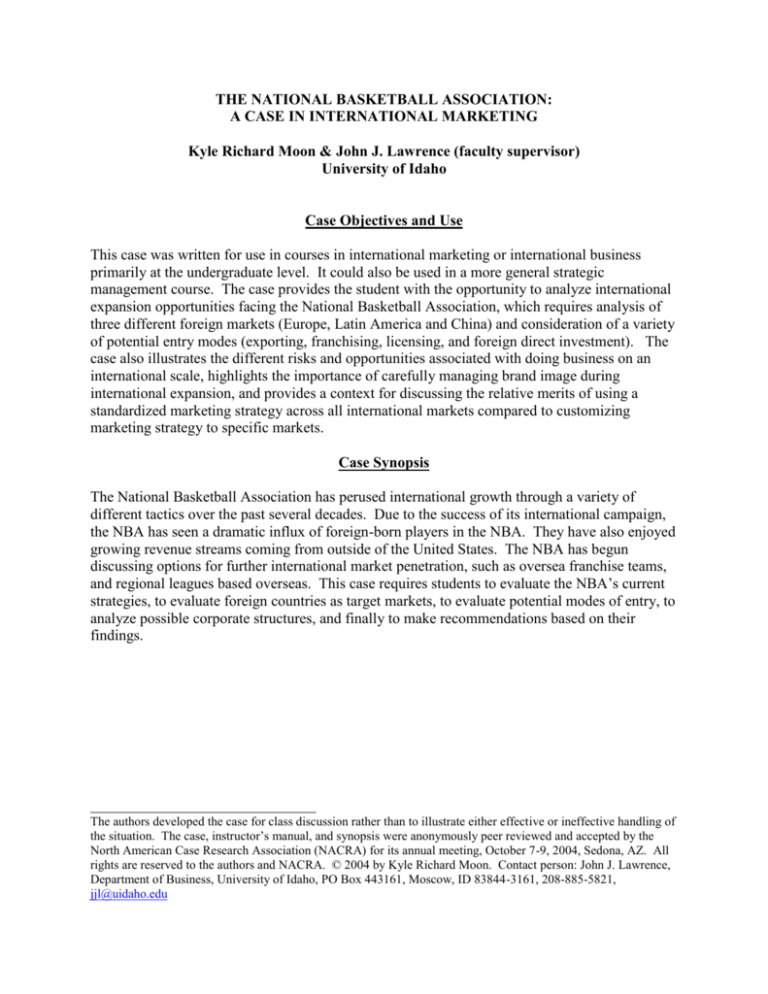
THE NATIONAL BASKETBALL ASSOCIATION:
A CASE IN INTERNATIONAL MARKETING
Kyle Richard Moon & John J. Lawrence (faculty supervisor)
University of Idaho
Case Objectives and Use
This case was written for use in courses in international marketing or international business
primarily at the undergraduate level. It could also be used in a more general strategic
management course. The case provides the student with the opportunity to analyze international
expansion opportunities facing the National Basketball Association, which requires analysis of
three different foreign markets (Europe, Latin America and China) and consideration of a variety
of potential entry modes (exporting, franchising, licensing, and foreign direct investment). The
case also illustrates the different risks and opportunities associated with doing business on an
international scale, highlights the importance of carefully managing brand image during
international expansion, and provides a context for discussing the relative merits of using a
standardized marketing strategy across all international markets compared to customizing
marketing strategy to specific markets.
Case Synopsis
The National Basketball Association has perused international growth through a variety of
different tactics over the past several decades. Due to the success of its international campaign,
the NBA has seen a dramatic influx of foreign-born players in the NBA. They have also enjoyed
growing revenue streams coming from outside of the United States. The NBA has begun
discussing options for further international market penetration, such as oversea franchise teams,
and regional leagues based overseas. This case requires students to evaluate the NBA’s current
strategies, to evaluate foreign countries as target markets, to evaluate potential modes of entry, to
analyze possible corporate structures, and finally to make recommendations based on their
findings.
The authors developed the case for class discussion rather than to illustrate either effective or ineffective handling of
the situation. The case, instructor’s manual, and synopsis were anonymously peer reviewed and accepted by the
North American Case Research Association (NACRA) for its annual meeting, October 7-9, 2004, Sedona, AZ. All
rights are reserved to the authors and NACRA. © 2004 by Kyle Richard Moon. Contact person: John J. Lawrence,
Department of Business, University of Idaho, PO Box 443161, Moscow, ID 83844-3161, 208-885-5821,
jjl@uidaho.edu
TATA TEA LIMITED: THE TETLEY ACQUISITION
Ram Subramanian, Grand Valley State University
Pradeep Gopalakrishna, Pace University
V.J. Sivakumar, Loyola Institute of Business Administration
Case Objectives and Use
The main teaching objective of this case is to assess acquisition as a mode of global expansion.
Tata Tea Limited acquired Tetley to expand globally. This case allows for a look at both the
pros and cons of using this mode for global expansion. The second objective is to assess the
acquisition using Michael Porter’s framework which uses three questions for assessment.
This case is intended for the undergraduate capstone strategy course either as part of the chapter
on global strategies or as part of the chapter on corporate strategy dealing with acquisitions.
Case Synopsis
In March 2000, India’s Tata Tea Limited (TTL) acquired the U.K. based Tetley Group for $481
million. It was the largest ever acquisition by an Indian firm. TTL’s motivation for the
acquisition was to become a global player in the tea industry. After the acquisition, TTL became
the world’s second largest tea company, after Unilever. The high cost of the acquisition, coupled
with an increasingly competitive U.K. tea market presented significant challenges for P.T.
Siganporia, the newly designated acting head of TTL. He was charged by the company’s Board
to help propel the company toward worldwide leadership.
The authors developed the case for class discussion rather than to illustrate either effective or ineffective handling of
the situation. The case, instructor’s manual, and synopsis were anonymously peer reviewed and accepted by the
North American Case Research Association (NACRA) for its annual meeting, October 7-9, 2004, Sedona, AZ. All
rights are reserved to the authors and NACRA. © 2004 by Ram Subramanian, Pradeep Gopalakrishna and V.J.
Sivakumar. Contact person: Ram Subramanian, Department of Management, Seidman School of Business, Grand
Valley State University, 401 West Fulton Street, Grand Rapids, MI 49504, 616-331-7442, subramar@gvsu.edu
MANGO: THE U.S. MARKET
Josep Franch, ESADE – Universitat Ramon Llull
Case Objectives and Use
This case was written to illustrate the difficulties of introducing a company in a very large,
highly competitive and mature market and for discussing entry barriers and cultural differences
between countries. Entry barriers are one of the basic issues of the case. The entry of China into
the WTO introduces some changes in the discussion of the advantages and disadvantages of
entering the U.S. market.
Market preferences or cultural differences are also basic issues in this case study. The concept of
fashion and the style of dressing are different in each culture. What works in one country does
not necessarily work in another. Last, but not least, the size of the U.S. market introduces
logistical and market supply issues.
This was was initially written for an International Marketing course, and it can be used in various
sessions, depending on the course syllabus. However, the case can also be used in other courses
(for example, Cross-Cultural Management of International Retail Management.)
Case Synopsis
In November 2001, Mango was considering entering the U.S. market. Founded in 1984 by Isak
Andic, Mango was expecting to be present in 60 countries with more than 650 outlets by the end
of 2001.
Addressing young modern, urban women aged 17 to 35, Mango was a leading Spanish brand in
the apparel business. The international expansion of Mango and another two companies in the
industry improved the way Spanish apparel products were perceived, as well as the international
competitiveness of Spanish textile brands, something that had seemed impossible a few years
earlier when Italian manufacturers dominated the scene. Mango was also an interesting story of
entrepreneurial success.
The company had considered entering the U.S. market on various occasions, but entry barriers,
cultural issues and logistic problems had prevented this move. In November
2001, China joined the World Trade Organization. Mango produced 45% of its clothing
in China; therefore, some of the entry barriers to the U.S. market were about to disappear.
The author developed the case for class discussion rather than to illustrate either effective or ineffective handling of
the situation. The case, and instructor’s manual, and synopsis were anonymously peer reviewed and accepted by the
North American Case Research Association (NACRA) for its annual meeting, October 7-9, 2004, Sedona, AZ. All
rights are reserved to the author and NACRA. © 2004 by Josep Franch. Contact person: Josep Franch, ESADE –
The Universitat Ramon Llull, 34-93-280-6162, franch@esade.edu
INTERNATIONAL BUSINESS IN EDUCATION: A CASE STUDY
Jeffrey E. Michelman & Steven K. Paulson
University of North Florida
Case Objectives and Use
There are three distinct teaching objectives that this case may pursue. First, the case may focus
on the design of related educational functions and mechanical difficulties encountered by the
U.S. school in terms of the following subtopics: Faculty, Admission, Prerequisites, General
Education, Curriculum, Tuition, Prerequisites, Scheduling Classes, Student Registration,
Scholarships, Financial Management and Financial Aid. Secondly, the case may be used as a
vehicle for discussion of underlying, more causal, issues including multiculturalism and conflicts
resulting from profit/nonprofit motivations. Third, the case may be used to illustrate broader
theoretical concepts in the area of organization strategy. The teaching suggestion which follows
permits an incorporation of elements which reflect all three of these objectives.
The case may be used at the undergraduate or graduate level in (1) international business
management or policy which give emphasis to interorganizational relationships and (2)
educational leadership courses which give emphasis to multicultural elements of program design.
Case Synopsis
Over the past 20 years, business schools throughout the United States have worked to both
internationalize their curriculums and make international opportunities available for their
students. More recently many business schools have developed programs abroad, which allow
students to earn a U.S. degree in their home country. In this sense, American Business Schools
have begun to “sell” their product abroad. This case describes one such attempt by a U.S.
university business school to establish a degree program at the undergraduate level in a
Caribbean nation and how cultural and university curriculum constraints transcended the
requirements of business education.
The authors developed the case for class discussion rather than to illustrate either effective or ineffective handling of
the situation. The case, instructor’s manual, and synopsis were anonymously peer reviewed and accepted by the
North American Case Research Association (NACRA) for its annual meeting, October 7-9, 2004, Sedona, AZ. All
rights are reserved to the authors and NACRA. © 2004 by Jeffrey E. Michelman and Steven K. Paulson. Contact
person: Jeffrey E. Michelman, Coggin College of Business, University of North Florida, 4567 St. Johns Bluff Rd.,
Jacksonville, FL, 32224, 904-620-1541, jmichelm@unf.edu
ARIES CATERING AND ARIES TOURS
OF ARMENIA
Marlene M. Reed, Samford University
Rochelle R. Brunson, Alvin Community College
Case Objectives and Use
This case explores the challenges faced by new businesses opened in Armenia since the fall of
Communism. Some of these challenges are under the control of the entrepreneur, but some
appear to be uncontrollable because they are systemic problems within the government. The
ventures which illustrate the plight of these businesses are Aries Catering and Aries Tours of
Armenia launched by Avetik Ghukasyan. The case was developed for use in an undergraduate
international business class because it should help students interested in the context of the
international environment give serious reflection to the transition from a planned to a free market
economy. It also raises questions about the ability of entrepreneurs to influence government
policies that affect their operations.
Case Synopsis
The focus of the case is on an Armenian entrepreneur named Avetik Ghukasyan whose business
had grown appreciably in the past but faced increasing problems with labor, competition and
lack of laws to foster the initiation and growth of small business in the country. One of his
greatest challenges was recruiting a dedicated work force since the older workers had lived so
long with the lack of a strong work ethic that they found it hard to change, and the younger
workers had no role models supporting a strong work ethic and often became discouraged with a
lack of job opportunities.
In addition, Avetik was having to learn to live with the reality of competition in a country where
there had been only one business in an industry under the Communists. Because his business
had been so successful, he was now faced with the reality that more and more companies were
entering the industry and making it difficult for him to operate a profitable business.
The authors developed the case for class discussion rather than to illustrate either effective or ineffective handling of
the situation. The case, instructor’s manual, and synopsis were anonymously peer reviewed and accepted by the
North American Case Research Association (NACRA) for its annual meeting, October 7-9, 2004, Sedona, AZ. All
rights are reserved to the authors and NACRA. © 2004 by Marlene M. Reed and Rochelle R. Brunson. Contact
person: Marlene M. Reed, School of Business, Samford University, Birmingham, AL 35229, (205) 726-2542,
mmreed@samford.edu
WAL-MART de MÉXICO:
STRATEGIES AND CHALLENGES IN MÉXICO
James W. Camerius, Northern Michigan University
Walter E. Greene, The University of Texas Pan American
Case Objectives and Use
This case was primarily intended for use in both undergraduate and graduate classes in
International Business. However, it is also suitable for use in International Marketing and
Strategic Management/Business Policy classes.
The objectives of this case were fourfold. First, it is the objective to familiarize students with
current business practices in Mexico. The second objective was to acquinate students with some
problems of dealing in another culture than their own. Inflation and dealing with an unstable
foreign currency was the third object, and the last objective was to discuss specific cross-border
custom inspection problems.
Case Synopsis
Wal-Mart became an international company in 1991 when a SAM’S CLUB opened near México
City, México. Just two years later, the Wal-Mart International Division was created to oversee
growing opportunities worldwide. Today, customers at more than 1,300 units in nine countries
prove that Wal-Mart Every Day Low Price promise is a message clearly understood in any
language. The division currently operates stores and clubs employing more than 300,000
associates in Argentina, Brazil, Canada, China, Germany, Japan, Korea, México, Puerto Rico,
and the United Kingdom.
In 1991, Wal-Mart entered into a Joint Venture with Cirfa with the opening of a Sam’s Club in
México City, and México became the first country in the International Division. In 1997, WalMart acquired a majority position in Cirfa and its shares were traded on the Méxican Stock
Exchange, and in February 2000 the name changed to Wal-Mart de México, S.A. de C.V. The
company’s ticker symbol changed from CIRFA to WALMEX. Nation-wide, Wal-Mart de
Mexico operates 640 units in 31 Méxican states with annual sales of US$10.6 billion. In 2004,
Wal-Mart Stores, Inc., Bentonville, Arkansas, was not only the nation’s largest discount
department, but had also surpassed Sears, Roebuck & Co. in sales volume as the largest retail
firm in the United States. It was considered the largest retailer and largest company in the world,
with 4,906 units and sales of $256.329 billion in fiscal year ending January 31, 2004.
The authors developed the case for class discussion rather than to illustrate either effective or ineffective handling of
the situation. The case, instructor’s manual, and synopsis were anonymously peer reviewed and accepted by the
North American Case Research Association (NACRA) for its annual meeting, October 7-9, 2004 Sedona, AZ. All
rights are reserved to the authors and NACRA. © 2004 by James W. Camerius and Walter E. Greene. Contact
person: James W. Camerius, Northern Michigan University, Cisler College of Business, 1401 Presque Isle Avenue,
Marquette, MI 49855-5353, 906-227-1245, fax-227-2930, jcameriu@nmu.edu
CARREFOUR: CONQUER OF LATIN AMERICA
Ashok Som, ESSEC Business School, Paris
Case Objectives and Use
The main purpose of the case is to make the students aware of the Latin American market
through the example of a multinational company that has a well developed strategic intent for
conquering the Latin American market, has implemented successfully its strategic intent and
where it couldn’t (failed) exited from the market. Thus the case shows both the success
(Colombia) and the failure (Chile) that the organization Carrefour has experienced in the Latin
American market. The Case objectives are as follows:
1. To illustrate one of the fastest international growth strategies (mainly by acquisitions)
2. To illustrate and make students aware of the retail sector in general and the retail sector in
France
3. To illustrate the strong linkage between a company’s organizational capabilities, its
strategic intent and its core competencies
To evaluate the multi-format strategy that Carrefour employs to integrate local responsiveness,
global scale efficiency while evolving a capability to learn not only from its worldwide
successful innovations but also from its failures
Case Synopsis
Carrefour, since its merger with Promodès in 1999, is ranked as the French world challenger and
the European leader in the retail industry. Carrefour followed an aggressive growth strategy by
starting to become global from the early 1970s. Its first mover advantage in the international
retail sector market helped it reach a leadership position either by acquiring local actors or by
adapting itself to local cultures and consumer habits and has made it the second largest retail
company worldwide. Carrefour did witness much success in penetrating the developed markets
of the United States and the UK but Carrefour has successfully implemented its multi-format
strategy in Europe, Asia and Latin America. The Latin American market has been an area
presenting the highest growth rate for Carrefour specially in countries like Colombia where the
growth rate at comparable exchange rates has been over 30% in year 2003. The case discusses
and highlights the (a) entry strategy of Carrefour and the Latin market (b) its growth strategy by
acquisitions (c) the linkage of its strategic intent of profitability, core competence, organizational
capability and its business strategy (d) marketing, pricing, branding, use of private label strategy
(e) its overall strategy of conquering markets by fast local adaptation to individual markets and
its responsiveness to local businesses focusing on Latin America and the Colombian market.
The author developed the case for class discussion rather than to illustrate either effective or ineffective handling of
the situation. The case, instructor’s manual, and synopsis were anonymously peer reviewed and accepted by the
North American Case Research Association (NACRA) for its annual meeting, October 7-9, 2004, Sedona, AZ. All
rights are reserved to the authors and NACRA. © 2004 by Ashok Som. Contact person: Ashok Som, Strategy and
Business Area, ESSEC Business School, Paris; Avenue Bernard Hirsch, B. P. 50105, Cergy-Pontoise, Cedex,
France, 95021. +33 1 34 43 30 73, som@essec.fr
RESTRUCTURING OF A NATIONAL CHAMPION: THE CASE OF ALSTOM
Ashok Som, ESSEC Business School
Case Objectives and Use
The main purpose of the case is intended to provide the students with the opportunity to
analyze and understand the role of the state, the pros and cons of a State intervention in a
particular industrial sector. It focuses on the issues that Alstom, a former world leader in
several sub-sectors of the power generation industry, had to face.
The case can be used in a variety of MBA and executive courses in international strategy and
management, competitive strategy, business environment and general management. It is best
used in a course or a module focused on International Business/International Strategy and
Management, or more specifically, on the role of state in Managing Global Corporations.
Ideally the case throws light on issues in business environment, government bailouts and role of
the state. It reinforces Porter’s Diamond model to analyze the competitive advantage of nations
from a strategic perspective.
Case Synopsis
The case traces the evolution of Alstom from a family owned company to an industrial
diversified multinational which is currently in financial troubles. Alstom has been known for its
technological excellence which ranges from the power generation industry to the high speed
trains (TGV) – in both France’s and Alstom’s flagship of technological success. In June 1998,
GEC ALSTOM floated the company on the New York, London and Paris stock exchanges under
the new company name ALSTOM. This IPO is now seen as the main reasons for Alstom’s
current financial turmoil. It is said that synergies which were in place between Alstom and other
subsidiaries of the former Alcatel-Alstom conglomerate were lost and value destroyed after the
launch of the IPO. Furthermore Alstom had to pay a special dividend of €1.2 billion to Alcatel
and General Electric Co which severely diminished its available cash flow and hence its
capability to innovate and destroying its core competence. The case tries to illustrate the
evolution of a French conglomerate and its relationship with the French State since its inception
in 1898. Historically the French state has helped Alstom from its inception starting from
establishing its technological prestige through the TGV project, demerging Alstom from Alcatel,
and finally when refinancing Alstom with a bail-out package of 3.4 billion Euros to prevent it
from going bankrupt. The case tries to understand the issues of competitive advantage of nations
and the role of the state in the light of the Alstom example.
The author developed the case for class discussion rather than to illustrate either effective or ineffective handling of
the situation. The case, instructor’s manual, and synopsis were anonymously peer reviewed and accepted by the
North American Case Research Association (NACRA) for its annual meeting, October 7-9, 2004, Sedona, AZ. All
rights are reserved to the authors and NACRA. © 2004 by Ashok Som. Contact person: Ashok Som, Strategy and
Business Area, ESSEC Business School, Paris; Avenue Bernard Hirsch, B.P. 50105, Cergy-Pontoise, Cedex,
France, 95021. +33 1 34 43 30 73, som@essec.fr
NATURE’S WAY PRODUCTS, INC. – THE MARKETING OF NATURAL MEDICINES
IN RUSSIA: MULTI-LEVEL MARKETING (MLM) OR TRADITIONAL CHANNELS?
Harold Koch & Amy Christensen
Utah Valley State College
Case Objectives and Use
This actual international case deals with a difficult channel decision being made by a leader in a
little-studied industry – Dietary Supplements (natural medicines). Nature’s Way Products, Inc.,
located in Utah, is recognized for its scientific research in an industry fraught with mystery and
constant threat of greater government regulation. The central decision point in the case is that,
given the Russian economic crisis since 1998, Nature’s Way has lost 50% of its sales to cheaper
local supplement manufacturers and it must find a solution. The International Projects
Coordinator is analyzing her channel design as part of the solution in order to get more products
on the shelves in Russia and compete with local producers selling at half the price. An additional,
important issue in this case is the ethics potentially involved with a proposed change to MultiLevel Marketing selling techniques, which are often associated with illegal / unethical pyramid
schemes. The case was written for business school undergraduate or graduate courses in
International Business, International Marketing, or Business Ethics.
Case Synopsis
The International Projects Coordinator of Nature’s Way Products, Inc. is preparing for a seven
day trip to Russia and investigating the consequences if a change were made from a traditional
marketing channel (exporting to a full-service Merchant Wholesaler in Moscow who distributes
through pharmacies) to a Multi-Level Marketing (MLM) channel. Many large multinationals in
this estimated $58 billion dollar global industry are already using MLM and while Nature’s Way
Products, Inc. has no prior experience, it is an alternative that must at least be evaluated. The task
of recruiting, motivating, compensating, and training downline, multi-commissioned, selling
agents (Russian women) is complicated and it could evolve into an illegal / unethical pyramid
scheme if proper selling and management controls are not implemented. These are the two
central decision points of the case while the reader will learn about a very mysterious and oftenmisunderstood marketing channel (MLM) that is very rarely discussed in academic classrooms.
In addition it will be necessary to prepare a skeletal pro forma financial statement to compare the
traditional channel with the MLM model. An ethics decision tree is included in the case to help
the students arrive at a balanced decision. The case ends with the International Projects
Coordinator accumulating industry and financial data in order to present a 3-page memorandum
to senior management the following day.
The authors developed the case for class discussion rather than to illustrate either effective or ineffective handling of
the situation. The case, instructor’s manual, and synopsis were anonymously peer reviewed and accepted by the
North American Case Research Association (NACRA) for its annual meeting, October 7-9, 2004, Sedona, AZ. All
rights are reserved to the authors and NACRA. © 2004 by Harold Koch and Amy Christensen. Contact person:
Harold Koch, School of Business, Utah Valley State College, 800 West University Parkway, Orem, UT 84058-5999,
801-863-7198, KochHa@uvsc.edu
THE PORT OF GUANGZHOU: ON THE EVE OF TRANSFORMATION
Laura Whitcomb & Kern Kwong
California State University
Kui Shen,Administrative Committee of GETDD
Case Objectives and Use
This case would be appropriate for courses in international business or strategic management.
For international business, the case could be used in an international logistics course or in a
course devoted in whole or in part to business in China. The case could be used at the
undergraduate or graduate levels. The primary objectives of the case are to illustrate key trends
in Pacific Rim trade and to help students understand the infrastructure and logistics underlying
globalization and the growth of China trade.
Case Synopsis
In early 2003, the Port of Guangzhou faced a number of challenges. Rapid economic growth in
south China meant that more facilities would be required for this gateway port to handle more
raw materials coming in and manufactured goods going out. Containerization and the shift to
larger and larger container ships threatened the viability of this historical river port, and it needed
to find ways to develop further downriver towards the ocean if it was to achieve its goal of
becoming a modern, world-class port. A joint venture with Singapore’s PSA was helping to
achieve this goal. However, the deepwater port of Yantian, located nearby in Shenzhen at the
mouth of the Pearl River delta, was developing rapidly with the support of terminal operator
Hutchison Whampoa, and might make the port of Guangzhou obsolete.
At the same time, the governance of the port was in transition. The port was organized into
companies that ran the terminals and administrative divisions that supervised them, all of which
were under the administration of a government bureau. In general, it is not unusual for ports
worldwide to be government-owned, even in the U.S. However, under central planning,
government regulators and business operators tended to be merged, and thus, as part of economic
reform in China, it was seen as desirable to create new entities which would distinguish the
government functions of port oversight from the business functions of port operation. The form
this transformation would take was still under discussion, but it was targeted for completion by
the end of the year.
The authors developed the case for class discussion rather than to illustrate either effective or ineffective handling of
the situation. The case, instructor’s manual, and synopsis were anonymously peer reviewed and accepted by the
North American Case Research Association (NACRA) for its annual meeting, October 7-9, 2004, Sedona, AZ. All
rights are reserved to the authors and NACRA. © 2004 by Laura Whitcomb, Kern Kwong, and Kui Shen. Contact
person: Laura Whitcomb, Dept. of Management, College of Business & Economics, California State University, Los
Angeles, 5151 State University Drive, Los Angeles, CA 90032, 323-343-2910, lwhitco@calstatela.edu



